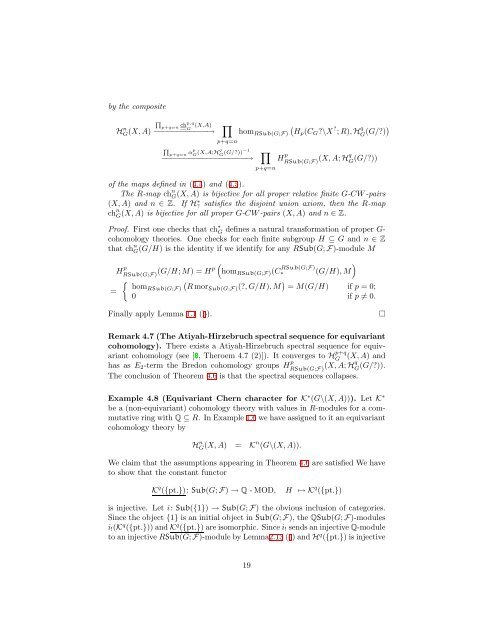Equivariant Cohomological Chern Characters
Equivariant Cohomological Chern Characters
Equivariant Cohomological Chern Characters
Create successful ePaper yourself
Turn your PDF publications into a flip-book with our unique Google optimized e-Paper software.
y the composite∏p+q=n chp,q(X,A)HG(X, n GA) −−−−−−−−−−−−→∏p+q=n∏p+q=n αp G (X,A;Hq G (G/?))−1−−−−−−−−−−−−−−−−−−−→hom RSub(G;F)(Hp (C G ?\X ? ; R), H q G (G/?))∏p+q=nH p RSub(G;F) (X, A; Hq G (G/?))of the maps defined in (4.4) and (4.5).The R-map ch n G(X, A) is bijective for all proper relative finite G-CW -pairs(X, A) and n ∈ Z. If H?∗ satisfies the disjoint union axiom, then the R-mapch n G(X, A) is bijective for all proper G-CW -pairs (X, A) and n ∈ Z.Proof. First one checks that ch ∗ G defines a natural transformation of proper G-cohomology theories. One checks for each finite subgroup H ⊆ G and n ∈ Zthat ch n G(G/H) is the identity if we identify for any RSub(G; F)-module M=H p RSub(G;F) (G/H; M) = Hp ( hom RSub(G;F) (C RSub(G;F)∗)(G/H), M{homRSub(G;F)(R morSub(G;F) (?, G/H), M ) = M(G/H) if p = 0;0 if p ≠ 0.Finally apply Lemma 1.1 (b).Remark 4.7 (The Atiyah-Hirzebruch spectral sequence for equivariantcohomology). There exists a Atiyah-Hirzebruch spectral sequence for equivariantcohomology (see [3, Theroem 4.7 (2)]). It converges to H p+qG(X, A) andhas as E 2 -term the Bredon cohomology groups H p RSub(G;F) (X, A; Hq G (G/?)).The conclusion of Theorem 4.6 is that the spectral sequences collapses.Example 4.8 (<strong>Equivariant</strong> <strong>Chern</strong> character for K ∗ (G\(X, A))). Let K ∗be a (non-equivariant) cohomology theory with values in R-modules for a commutativering with Q ⊆ R. In Example 1.6 we have assigned to it an equivariantcohomology theory byH n G(X, A) = K n (G\(X, A)).We claim that the assumptions appearing in Theorem 4.6 are satisfied We haveto show that the constant functorK q ({pt.}): Sub(G; F) → Q - MOD,H ↦→ K q ({pt.})is injective. Let i: Sub({1}) → Sub(G; F) the obvious inclusion of categories.Since the object {1} is an initial object in Sub(G; F), the QSub(G; F)-modulesi ! (K q ({pt.})) and K q ({pt.}) are isomorphic. Since i ! sends an injective Q-moduleto an injective RSub(G; F)-module by Lemma2.13 (c) and H q ({pt.}) is injective19
















